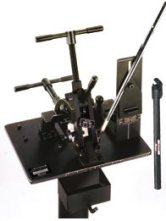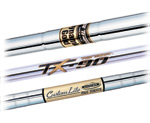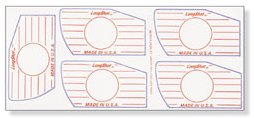Shape Up Your Clubs: A Checkup for Better Play
by Jeff Jackson, Tour Golf Products
Lower my handicap. Play more consistently. Take lessons. Get the right equipment. Resolutions for an improved golf game for sure. The first three take a good deal of time, expense and effort, something most of us don't have enough of at any time. But, an "Equipment Resolution" might just be the most time and cost effective method toward lower scores for the remainder of the year! Do you have to spend tons of money on new equipment? Probably not. Will it take a long time to make sure your clubs are in good shape? Not at all. An equipment evaluation might just be one of the wisest moves you'll ever make. Let's look a bit further.
A golf club has three basic parts: the head, the shaft and the grip. A close look at each of these parts by you and your pro or clubmaker will ensure that these parts match each other as best they can so they will work in concert with your swing. How long will it take? A couple of hours at most. How much will it pay off? 'Hard to say, but if you know your equipment is right, the gain in confidence alone should produce lower scores! Plus, as you are about to learn, less-than-accurate specifications often yield less-than-accurate results.
We'll start with the club head. Take a look for scratches, nicks, dents, rust or worn spots. While these might not directly relate to how well the club performs, they certainly do make the club look less than perfect. If you play oversize metal woods, have your pro or clubmaker put a radius gauge on their faces. The gauge will show if there are high or low spots on the club face - something that can lead to errant shots. Maybe it isn't your swing making those drives go consistently one way or the other…
Often your current clubs can be refinished or polished to bring them back to looking nearly new. If you really like your clubs, you may want to consider such an option. Refinishing is not all that expensive, and it will make your clubs look new at a fraction of the cost of actual new equipment. Even if you don't go for a full refinish of your irons, the faces of your irons can be sandblasted, adding the potential for more spin and accuracy on scoring shots leading toward lower scores.
A key part of your club evaluation will be a check of your clubs for the proper lofts and lies. If the lie is out of adjustment as little as 1 degree, shot direction can noticeably be compromised. You might not notice on long irons shots, but on wedge shots to the green, that single degree can mean the difference between being in a bunker or on the green. Loft is equally important. There are only 3-4 degrees of loft between each club. If, for example, the #5 iron was a bit weak and the #6 was a bit strong, you could, in effect, have two clubs in the set that hit the ball the same distance. Think about it for a moment…does your set have such clubs? A simple loft alteration can cure such distance gaps. Lofts and lies can work their way out of adjustment from hitting balls on the range, maybe hitting a tree root at some point, and just through normal daily play. It's always a good idea to get these specifications checked and set at least once a year. What about shafts? First take a look at your shafts. Are there any dents or rust on the steel shafts? If so, this is a sign that breakage may be imminent. Better to get the shaft(s) replaced now rather than have one break and injure someone on the course. If you play graphite shafts, look for any fraying where the shaft goes into the head. Also look for noticeable wear at any point on the shaft, particularly where the shafts rest against the bag as you carry it. You pro or clubmaker can let you know if the wear is excessive or if it's just cosmetic. Are there any rattles in the shafts? Rattles are most often caused by loose weights in the shaft. These can be repaired quickly and inexpensively. While they may not affect playability, they can be unnerving as you swing or waggle your club. While you're at it, check out the ferrule (The ferrule is the plastic trim piece where the shaft enters the head) to see if it is loose. Loose ferrules can be epoxied back in place in an effort to make the club look like new. If you are genuinely serious about your game, you should consider having a deflection or frequency test done on your clubs. Either test compares your clubs to one another to see if they match. A deflection test will show if the shafts all bend in a uniform manner. It only makes sense that if the shafts exhibit the same bending profile they will feel and play more consistently. A frequency test is more of a high-tech specification check. Each club is placed on a frequency machine and oscillated. The number of times the shaft oscillates between sensors is called the "cycles per minute" or cpm's. Through the set of clubs, there should be an equal number of cpm's between each club. Any club showing a higher cpm rating than it should have will play stiffer than expected; one oscillating at less cpm's than expected is softer. The frequencies of all of your shafts will be plotted on a graph providing a distinct visual image of how they match to one another. |
|
What does this mean to your game? To an experienced player - and even to a beginner - it means that not all clubs in the set will perform in the same manner even if the swings are perfect. What can you do about it? Unfortunately, just about the only cure is to replace the non-matching shaft or shafts. Frequency matching ensures that all shafts in the set will feel and play in the same manner. If you want to be certain that your clubs perform exactly as they were intended, have them "frequed"; you may be surprised at the results.
| If new shafts are in order, be sure you have them fitted to the proper length. The person evaluating your clubs should have some face impact labels to show where on the face you contact the ball. The length that best fits you is the one that you hit most consistently. You want the longest club that you can control; longer clubs can add distance to your shots, but only if they are hit consistently. The face label test is a good way to make sure your new shafts are best fitted to your swing. The next step in the club evaluation process is to look at the grips. They are the only place at which you have direct contact with the club. Making certain that your grips are in top shape and that they fit your hands is a prerequisite to improved play. Your clubs should have new grips at least once each season. Make sure you have the correct size grips put on your clubs, don't select grips for cosmetic reasons only. Tour pros regrip their clubs every couple of weeks; it only makes sense you should do it at least once a year. |
|
A final consideration when evaluating your clubs this season is your set makeup. Set makeup is what clubs you are carrying. Think about your game. Where do you have the most trouble? Is it from the tee? Do most of your shots tend to go right? If so, look to replace your current driver with one that will help correct this errant shot tendency. A club with a closed face angle or a higher torque shaft may help turn your slices into fairway-finding trajectories. Do you have trouble on long shots from the rough? Any of the new, low center of gravity woods available may help answer this problem. If you haven't tried any of these designs, do yourself a favor and check them out; they may be a cure for a long-standing problem. What about your short game? If you have continual trouble around the green or in the sand, ask your pro or clubmaker to recommend a wedge with a loft and bounce that may help you play more accurate shots from the greenside conditions at your course. While new clubs can be expensive at times, the "new weapon" in your bag may inspire confidence and at the same time lower your scores.
Whether it's the heads, shafts, grips or set makeup, it is a wise golfer who checks his or her equipment every now and then. By being certain that you have matching equipment with the correct specifications that match your individual playing characteristics, you may already be a step ahead of the competition when you step on the first tee. The best players in the game are constantly evaluating their equipment; doing it on a regular basis will help you just the same!





